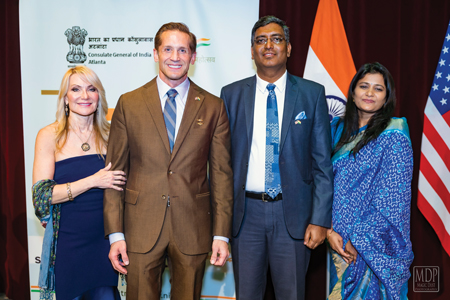Songs of Praise: Annamayya in poetry, music, and dance at Emory University

On September 21, the Performing Arts Studio at Emory University was filled with the songs of the fifteenth-century Telugu poet Annamayya. While Atlanta communities are privileged to have many opportunities to attend Indian music and dance performances in many different style, this one was unique in several ways in that it balanced equally music, poetry, and dance. The performance featured sankirtanas (“songs of praise”) of the fifteenth-century Telugu poet Annamayya, which were choreographed in the style of Kuchipudi dance and accompanied by a seven-person live orchestra. To highlight the poetry, line-by-line literal translations of the sankirtanas were projected on a screen above the dancers, a valuable contribution to experience the poetry for both non-Telugu and Telugu speakers. Several Telugu audience members commented that although they were well-acquainted with some of the songs, they experienced them in a new way with the translations readily available. Another unique aspect of this performance was the focus on a single poet, showcasing his wide-ranging poetic imagination—from the poet’s direct praise of the deity Vishnu and his incarnations (what are called adhyatma songs) to songs in the female voices of the goddess Alamelumanga (Venkateshwara’s consort) and/or her girlfriends (shringara sankirtanas)
Sasikala Penumarthi (Executive Director, Academy of Kuchipudi Dance and Artist Affiliate, Emory Dance Program) and two of her senior students, Reneeta Basu and Anoosha Kumar, performed seven sankirtanas choreographed by either Sasikala Penumarthi or her guru Dr. Vempati Chinna Satyam. These included the popular Muddugare Yashoda (“He’s the pearl before his loving mother Yashoda”) and Paluku Tennela Talli (“Goddess who speaks sweetly is sleeping”). The evening’s performance ended with the powerful Brahmamokkate (“All are one before God”). The display of the translation of the sung lines above the dancers made clear to the audience that one line was often repeated over and over, with the dancers’ movements elaborating on the narrative or image, demonstrating that dance is not simply a reflection of poetry but is an elaboration and intensification of narrative, image, and emotion.
Along with poetry and dance, the third crucial element of the performance was the exemplary seven-member live Carnatic orchestra, including Sastry Bhagavatula on nattuvangam; Subhashini Krishnamurthy as vocalist; Santosh Chandru on mridangam; Anjaneya Sastry on tabla; Lakshminarayana Pisupati on violin; Sai Kishore Ravisankar on flute; and Pallavi Dokka on veena.
The performance was enrichened by a brief introductory framing by Harshita Mruthinti Kamath (Associate Professor, Middle Eastern and South Asian Studies), who is currently writing a book on Annamayya and his sankirtanas. Many Telugu speakers have grown up hearing the songs of Annamayya on radio, television, and in vocal and dance performances; and his songs are still broadcast in the Tirumala Venkateshwara temple near Tirupati, Andhra Pradesh. It is said that he composed one new sankirtana every day for the god—totaling over 32,000 songs according to the hagiography composed by his grandson. Annamayya’s son began the massive undertaking of having his father’s sankirtanas (approximately 13,000 of them) engraved on copper plates, which were stored in a room right next to the inner sanctum of the temple. Today, approximately 2700 copperplates are housed in the Sri Venkateshwara Museum. Dr. Kamath emphasized how unusual this massive archive for a single pre-modern poet is, which demonstrates “Annamayya’s powerful and lasting influence in the landscape of Tirumala and south India more broadly.”
For both audience members who had never heard of Annamayya and for those who found themselves singing along or nodding their heads in recognition, the evening offered rich gifts of poetry, song, and dance and motivation to further pursue the sankirtanas of Annamayya’s extensive, creative repertoire composed for Tirumala’s God on the Hill, Venkateshwara.
The performance was organized by Telugu Studies at Emory and Asian Arts at Emory, with support of the Academy of Kuchipudi Dance and the Georgia Council for the Arts, as well as Emory’s Departments of Middle Eastern and South Asian Studies and Religion, the David Goldwasser Series in Religion and the Arts, the Dance Program, the Initiative for Arts and Humanistic Inquiry, the Fox Center for Humanistic Inquiry, and Emory’s student organizations of Hindu Students Association and Swara.
— Joyce Burkhalter Flueckiger
| Remember, we have new Website Bonus Features that are not in the print magazine. Every time you see the W symbol in the print magazine, you can go to our website to see additional print or audiovisual material! |
|
Submitting your report for consideration in Around Town Please send post event reports for consideration in the Around Town section to AroundTown@khabar.com. Publication of reports is based on several criteria including the volume of reports submitted for a given issue. Guidelines for the reports are on our website at http://www.khabar.com/magazine/around-town/guidelines_for_submitting_reports_to_around_town. Deadline: 15th of each month—for consideration in the following month. However, chances of inclusion are better if reports are received well in advance of the deadline – where possible, e.g. within 3-7 days of the event.
|
Enjoyed reading Khabar magazine? Subscribe to Khabar and get a full digital copy of this Indian-American community magazine.











